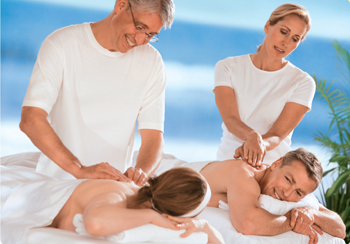47 Reduce Midlife Joint Pain with alternative therapies
Beyond exercising ( 39, 40), staying at a healthy weight (
39, 40), staying at a healthy weight ( 41), eating well (
41), eating well ( 44), and taking supplements (
44), and taking supplements ( 45, 46), some complementary approaches have shown promise for improving joint pain and other osteoarthritis symptoms. Acupuncture, transcutaneous electrical nerve stimulation, and massage can be helpful add-ons to other treatments and may be effective enough to allow you to reduce or even eliminate pain medications. Ask your doctor if it’s worth giving these therapies a shot; insurance may cover or subsidize them.
45, 46), some complementary approaches have shown promise for improving joint pain and other osteoarthritis symptoms. Acupuncture, transcutaneous electrical nerve stimulation, and massage can be helpful add-ons to other treatments and may be effective enough to allow you to reduce or even eliminate pain medications. Ask your doctor if it’s worth giving these therapies a shot; insurance may cover or subsidize them.
Consider Acupuncture to Reduce Age-Related Stiffness
Acupuncture is probably the best-studied alternative therapy for treating joint pain and osteoarthritis (OA). Originating in China, acupuncture developed as a technique for restoring the balance of energy, or qi, in the body. Practitioners insert thin needles in points of the body that correspond to painful areas; the resulting stimulation of nerves, muscles, and connective tissue releases your body’s natural painkillers (called endorphins), suppresses stress hormones such as cortisol, and boosts blood flow. Electro-acupuncture is a common variation that uses pairs of needles and mild, continuous electric pulses traveling between them to provide additional stimulation.
Studies on acupuncture show a small, short-term benefit for pain, but because of the difficulty of devising a placebo treatment, the actual effect has proved tricky to measure. Still, the results are promising. A 2008 review of studies in the journal Family and Community Health concluded that acupuncture is effective for improving pain and joint function in knee OA. And a 2010 study in the Chinese Medical Journal found that people with knee OA who received electro-acupuncture had reduced pain and several improved measures of joint function, including step length and walking pace.
Acupuncture has very few side effects and is considered quite safe if your practitioner is certified and uses sterile needles in a clean environment. However, you’ll have to continue treatment to keep seeing results.
Try Out TENS to Block Pain Signals
Similar to electro-acupuncture, transcutaneous electrical nerve stimulation (TENS) uses a small, battery-powered machine with electrodes you attach to your skin to send a low-voltage electrical current along nerve fibers. These electrical impulses stimulate the nerve endings near painful joints, potentially blocking pain signals to the brain and triggering a release of endorphins. After initial training on how to use the machine, you can do the therapy at home. It’s generally considered safe.
Several small trials have indicated that TENS can help relieve pain due to knee OA. And based on a review of current research, the Osteoarthritis Research International group, a team of sixteen medical professionals from six different countries, includes TENS as one of its twelve recommended nondrug treatments (along with acupuncture) to manage hip and knee OA.
A 2008 study in the American Journal of Physical Medicine and Rehabilitation found that combining hot packs and TENS reduced pain and improved function in women with knee OA. The TENS treatment group also showed increased muscle strength and better exercise performance compared to those who received ultrasound therapy plus hot packs, hot packs alone, or no treatment. And in a 2008 study in the journal Chinese Medicine, knee OA sufferers reported less pain and improved joint function after treatment with TENS. Those researchers found similar improvement with acupuncture and suggested that combining TENS and acupuncture would provide even greater benefits.

Massage for Greater Range of Motion and Joint Strength
Massage is helpful in reducing pain and increasing joint range of motion and strength. It works by encouraging blood flow to joints and stimulating endorphin release, and it may diminish pain-worsening stress hormones like cortisol as well. Because there are at least eighty different kinds of massage, gathering conclusive evidence about its effects on joint pain has proved difficult. However, a 2006 study in the Archives of Internal Medicine found that Swedish massage (twice weekly for a month, then weekly for another month) significantly improved knee pain, stiffness, and joint function in OA sufferers compared to those who didn’t receive massage. With very little downside, and potential benefits beyond relieving OA symptoms (it feels so good!), health-care practitioners frequently recommend massage to alleviate OA pain.
 39, 40), staying at a healthy weight (
39, 40), staying at a healthy weight ( 41), eating well (
41), eating well ( 44), and taking supplements (
44), and taking supplements ( 45, 46), some complementary approaches have shown promise for improving joint pain and other osteoarthritis symptoms. Acupuncture, transcutaneous electrical nerve stimulation, and massage can be helpful add-ons to other treatments and may be effective enough to allow you to reduce or even eliminate pain medications. Ask your doctor if it’s worth giving these therapies a shot; insurance may cover or subsidize them.
45, 46), some complementary approaches have shown promise for improving joint pain and other osteoarthritis symptoms. Acupuncture, transcutaneous electrical nerve stimulation, and massage can be helpful add-ons to other treatments and may be effective enough to allow you to reduce or even eliminate pain medications. Ask your doctor if it’s worth giving these therapies a shot; insurance may cover or subsidize them.